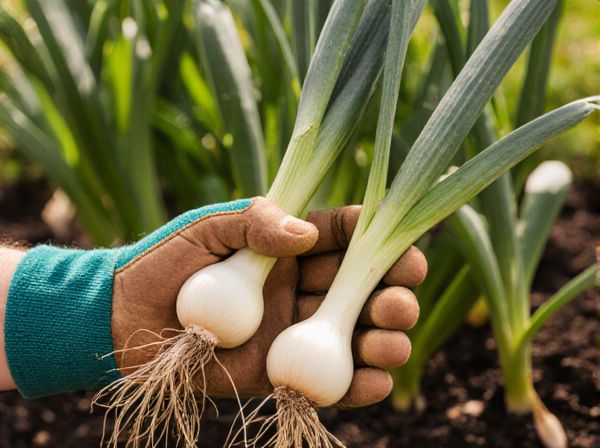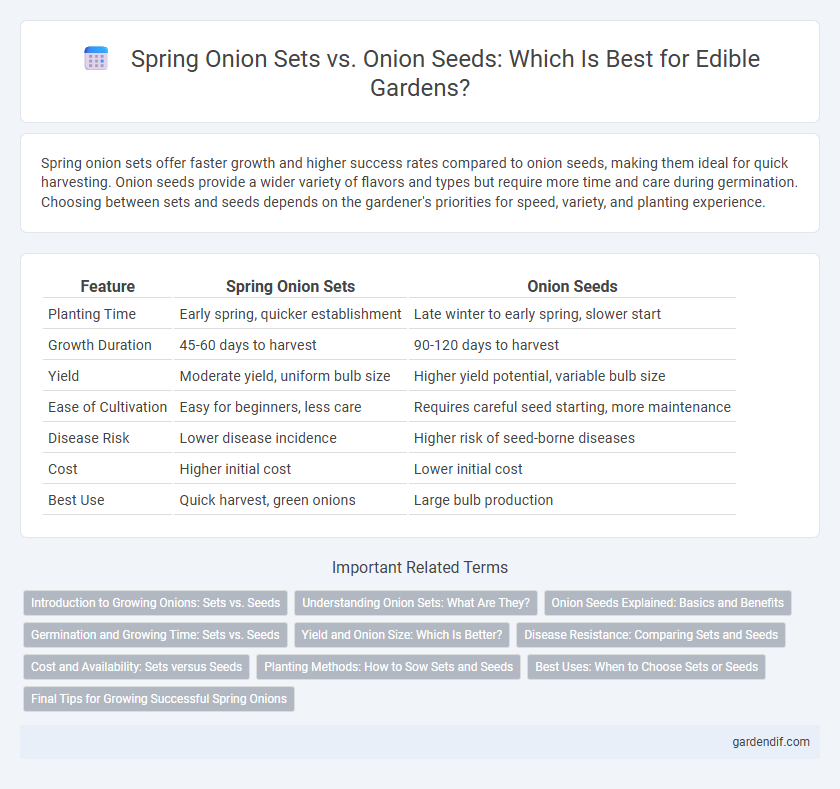
Spring onion sets vs Onion seeds Illustration
Spring onion sets offer faster growth and higher success rates compared to onion seeds, making them ideal for quick harvesting. Onion seeds provide a wider variety of flavors and types but require more time and care during germination. Choosing between sets and seeds depends on the gardener's priorities for speed, variety, and planting experience.
Table of Comparison
| Feature | Spring Onion Sets | Onion Seeds |
|---|---|---|
| Planting Time | Early spring, quicker establishment | Late winter to early spring, slower start |
| Growth Duration | 45-60 days to harvest | 90-120 days to harvest |
| Yield | Moderate yield, uniform bulb size | Higher yield potential, variable bulb size |
| Ease of Cultivation | Easy for beginners, less care | Requires careful seed starting, more maintenance |
| Disease Risk | Lower disease incidence | Higher risk of seed-borne diseases |
| Cost | Higher initial cost | Lower initial cost |
| Best Use | Quick harvest, green onions | Large bulb production |
Introduction to Growing Onions: Sets vs. Seeds
Spring onion sets offer a faster and more reliable method for growing onions compared to starting from onion seeds, with sets being small, immature bulbs that establish quickly. Onion seeds provide a broader variety of cultivars and greater control over growth conditions but require a longer germination and maturation period. Choosing between sets and seeds depends on desired harvest time, garden space, and available growing season length.
Understanding Onion Sets: What Are They?
Onion sets are small, immature onions harvested in the previous growing season and cured for storage, offering a quicker and more reliable method for growing onions compared to seeds. These sets establish roots rapidly and reduce the risk of disease, making them ideal for gardeners seeking early onion harvests. Unlike seeds, onion sets produce mature bulbs faster because they bypass the germination and seedling stages.
Onion Seeds Explained: Basics and Benefits
Onion seeds offer diverse varieties and allow for precise control over plant genetics, resulting in tailored flavors and sizes ideal for culinary uses. Unlike spring onion sets, seeds provide greater adaptability to different soil conditions and climates, enhancing overall yield and quality. Growing onions from seeds also ensures cost-effectiveness and extended planting options throughout the growing season.
Germination and Growing Time: Sets vs. Seeds
Spring onion sets offer faster germination and shorter growing time, typically sprouting within 7 to 10 days and ready for harvest in about 30 days. Onion seeds require a longer germination period of 10 to 14 days and a growing time of 90 to 120 days before maturity. Growing from sets provides an earlier yield but limits variety selection compared to starting from seeds.
Yield and Onion Size: Which Is Better?
Spring onion sets generally produce higher yields and larger onions compared to onion seeds due to their established growth stage and root system, enabling faster development. Onion sets mature more quickly and tend to produce bulbs with greater size uniformity, making them preferable for commercial harvests. Onion seeds, while offering more variety options, often result in smaller bulbs and lower yields, requiring longer growing periods and more careful management.
Disease Resistance: Comparing Sets and Seeds
Spring onion sets generally exhibit better disease resistance compared to onion seeds due to their established growth stage, which reduces vulnerability to soil-borne pathogens like Fusarium and downy mildew. Onion seeds, while offering greater genetic diversity, require more careful management to prevent early-stage diseases and may need fungicidal treatments to enhance survival rates. Choosing sets can lead to quicker, healthier crop establishment with fewer losses from common onion diseases.
Cost and Availability: Sets versus Seeds
Spring onion sets are generally more expensive than seeds but offer faster growth and higher initial success rates, making them a cost-effective choice for quick harvests. Onion seeds are less costly and more widely available, allowing gardeners to plant larger quantities with varied varieties but require longer growing time and more careful maintenance. Availability of sets can be seasonal and limited in some regions, while seeds are commonly stocked year-round in garden centers and online.
Planting Methods: How to Sow Sets and Seeds
Spring onion sets are planted by directly placing small, immature bulbs into well-drained soil about 1 inch deep and 2 inches apart, which allows for faster growth and early harvest. Onion seeds require starting indoors or in seed trays 8-10 weeks before the last frost, sowing seeds 1/4 inch deep, and thinning seedlings to 1-2 inches apart before transplanting outdoors. Sets provide a more straightforward, less labor-intensive planting method, while seeds offer greater variety and control over the growing process.
Best Uses: When to Choose Sets or Seeds
Spring onion sets provide a faster harvest and are ideal for gardeners seeking early yields or limited growing seasons. Onion seeds offer greater variety and cost-effectiveness, making them suitable for larger plots or specialized onion types like sweet or storage onions. Choosing between sets and seeds depends on the grower's timeline, desired onion variety, and garden space availability.
Final Tips for Growing Successful Spring Onions
Planting spring onion sets ensures faster establishment and higher germination rates compared to onion seeds, which require more time and care. Use well-drained, fertile soil rich in organic matter and maintain consistent moisture to promote healthy growth. Thin seedlings to at least 2 inches apart to prevent overcrowding and encourage larger, more robust spring onions.
Spring onion sets vs Onion seeds Infographic

 gardendif.com
gardendif.com